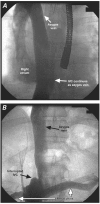Transhepatic approach to closure of patent foramen ovale: report of 2 cases in adults
- PMID: 20978566
- PMCID: PMC2953222
Transhepatic approach to closure of patent foramen ovale: report of 2 cases in adults
Abstract
Patent foramen ovale is increasingly diagnosed in patients who are undergoing clinical study for cryptogenic stroke or migraine. In addition, patent foramen ovale is often suspected as a cause of paradoxical embolism in patients who present with arterial thromboembolism. The femoral venous approach to closure has been the mainstay. When the femoral approach is not feasible, septal occluder devices have been deployed via a transjugular approach.Herein, we describe 2 cases of patent foramen ovale in which the transhepatic approach was used for closure. To our knowledge, this is the 1st report of a transhepatic approach to patent foramen ovale closure in an adult patient. Moreover, no previous case of patent foramen ovale closure has been reported in a patient with interrupted inferior vena cava.
Keywords: Brain ischemia/etiology; echocardiography, transesophageal; embolism, paradoxical/etiology/prevention & control; heart catheterization/methods; heart defects, congenital/therapy; hepatic veins; migraine disorders; patent foramen ovale; platypnea-orthodeoxia syndrome; prosthesis implantation/methods.
Figures



Comment in
-
Should patent foramen ovale be closed in patients with recent cryptogenic stroke or presumptive platypnea-orthodeoxia syndrome?Tex Heart Inst J. 2011;38(2):214-5. Tex Heart Inst J. 2011. PMID: 21494544 Free PMC article. No abstract available.
References
-
- Lechat P, Mas JL, Lascault G, Loron P, Theard M, Klimczac M, et al. Prevalence of patent foramen ovale in patients with stroke. N Engl J Med 1988;318(18):1148–52. - PubMed
-
- Anzola GP, Magoni M, Guindani M, Rozzini L, Dalla Volta G. Potential source of cerebral embolism in migraine with aura: a transcranial Doppler study. Neurology 1999;52(8): 1622–5. - PubMed
-
- Martin F, Sanchez PL, Doherty E, Colon-Hernandez PJ, Delgado G, Inglessis I, et al. Percutaneous transcatheter closure of patent foramen ovale in patients with paradoxical embolism. Circulation 2002;106(9):1121–6. - PubMed
-
- Sader MA, De Moor M, Pomerantsev E, Palacios IF. Percutaneous transcatheter patent foramen ovale closure using the right internal jugular venous approach. Catheter Cardiovasc Interv 2003;60(4):536–9. - PubMed
-
- Rao PS, Palacios IF, Bach RG, Bitar SR, Sideris EB. Platypnea-orthodeoxia: management by transcatheter buttoned device implantation. Catheter Cardiovasc Interv 2001;54(1):77–82. - PubMed
Publication types
MeSH terms
LinkOut - more resources
Full Text Sources
